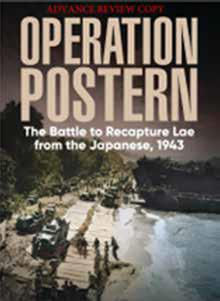Operation Postern: The Battle to Recapture Lae from the Japanese, 1943- Ian Howie-Willis
- Sep 8, 2023
- 3 min read
Updated: Aug 31
Some would say, what, another book on the taking of Lae? However, the author has produced one of the best modern campaign histories to date.
The book is well laid out and appendices provide additional information for those interested in the minutiae of detail or need to become aware of the structure of the units involved with a detailed listing of the teams involved in the amphibious landings, those involved in the Markham Valley and an explanation of the Australian Army Unit numbering system.
Like all good military history books, there is an excellent glossary to assist the reader in understanding the abbreviations and acronyms that are the norm in this type of writing.
The work is well-researched, with a comprehensive bibliography, including official records, standard reference works, other books and references to journal articles and relevant book chapters.
Additional references are for newspaper articles and materials in keeping with the age we live in, from the internet. The endnotes at the end of the book are very comprehensive.
But what makes this book stand out from other campaign histories? Campaign histories can be very dry and dull and useful at night if you need help getting to sleep. Operation Postern is not.
From the outset, a wide-ranging introduction will set the time and the historical record; brilliantly written and a big help to those who are knowledge deprived of the war in New Guinea.
Planning? Well, how boring is that? This author takes the reader through the planning stages in detail but logically from the highest decision-making body and their determination to retake Lae to the divisional planning of the two divisions involved. The chapter emphasises two facts: detailed planning is the reason for success and illustrates the planning process in military operations.

A chapter is devoted to each divisional operation and the Wau–Salamaua campaign linked to Operation Postern.
The issues raised by the escape of the garrison of Lae rate their own chapter, which includes some what-if scenarios that look at the potential problems if the garrison had been captured.
The author does not sugarcoat the command arguments between the 9 Division Commander and his brigade commanders or the attitude that prevailed of ‘take no prisoners’.
Unlike works written on the war in South West Pacific Area, both in the past closer to the events and more recently, the author devotes not only a chapter to the effect of the war on the indigenous population but refers to the hardship and cost to them in his other chapters.
Utilising case studies, the reader is given a brief understanding of what the war did to the people living in the Markham Valley and surrounding areas of Morobe Province during the war. He illustrates some of the motivating ideas behind the attitudes of ANGAU operatives and their postwar agenda and, at the same time, demonstrates the changes that came to the villages around Lae and how the war changed villagers’ thinking towards the Australian Government.
Overall, a valuable and insightful view of the operation to recapture Lae from the Japanese in 1943. The author should be commended for his approach and his introduction to this type of military history—the ‘Third Party’, the native people of Papua and New Guinea.
John Reeves
ISBN: 978-1-922896-14-8Published by Big Sky Publishing Pty Ltd (2023)(to be released 01/11/2023)Military history, 486 pages
Available from the publisher, via email: info@bigskypublishing.com.au; and web: www.bigskypublishing.com.au; also available from major retailers—Cost: $32.99




Comments